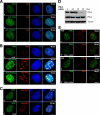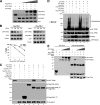PML3 Orchestrates the Nuclear Dynamics and Function of TIP60
- PMID: 19150978
- PMCID: PMC2659233
- DOI: 10.1074/jbc.M807590200
PML3 Orchestrates the Nuclear Dynamics and Function of TIP60
Abstract
The promyelocytic leukemia (PML) protein is a major component to govern the PML nuclear body (NB) assembly and function. Although it is well defined that PML NB is a site recruiting sumoylated proteins, the mechanism by which PML protein regulates the process remains unclear. Here we show that PML3, a specific PML isoform, interacts with and recruits TIP60 to PML NBs. Our biochemical characterization demonstrates that PML3 physically interacts with TIP60 via its N-terminal 364 amino acids. Importantly, this portion of TIP60 is sufficient to target to the PML NBs, suggesting that PML3-TIP60 interaction is sufficient for targeting TIP60 to the NBs. The PML3-TIP60 interaction is specific, since the region of TIP60 binding is not conserved in other PML isoforms. The physical interaction between PML3 and TIP60 protects TIP60 from Mdm2-mediated degradation, suggesting that PML3 competes with MDM2 for binding to TIP60. Fluorescence recovery after photobleaching analysis indicates that the PML3-TIP60 interaction modulates the nuclear body distribution and mobility of TIP60. Conversely, the distribution and mobility of TIP60 are perturbed in PML3-deficient cells, accompanied by aberrations in DNA damage-repairing response. Thus, PML3 orchestrates the distribution, dynamics, and function of TIP60. Our findings suggest a novel regulatory mechanism by which the PML3 and TIP60 tumor suppressors cooperate to ensure genomic stability.
Figures






Similar articles
-
PML3 interacts with TRF1 and is essential for ALT-associated PML bodies assembly in U2OS cells.Cancer Lett. 2010 May 28;291(2):177-86. doi: 10.1016/j.canlet.2009.10.009. Epub 2009 Nov 8. Cancer Lett. 2010. PMID: 19900757
-
Dynamics of component exchange at PML nuclear bodies.J Cell Sci. 2008 Aug 15;121(Pt 16):2731-43. doi: 10.1242/jcs.031922. Epub 2008 Jul 29. J Cell Sci. 2008. PMID: 18664490
-
TIP60 represses transcriptional activity of p73beta via an MDM2-bridged ternary complex.J Biol Chem. 2008 Jul 18;283(29):20077-86. doi: 10.1074/jbc.M800161200. Epub 2008 May 22. J Biol Chem. 2008. PMID: 18499675
-
PML nuclear bodies as sites of epigenetic regulation.Front Biosci (Landmark Ed). 2009 Jan 1;14(4):1325-36. doi: 10.2741/3311. Front Biosci (Landmark Ed). 2009. PMID: 19273133 Review.
-
Role of nuclear bodies in apoptosis signalling.Biochim Biophys Acta. 2008 Nov;1783(11):2185-94. doi: 10.1016/j.bbamcr.2008.07.002. Epub 2008 Jul 16. Biochim Biophys Acta. 2008. PMID: 18680765 Review.
Cited by
-
Connecting chromatin modifying factors to DNA damage response.Int J Mol Sci. 2013 Jan 24;14(2):2355-69. doi: 10.3390/ijms14022355. Int J Mol Sci. 2013. PMID: 23348929 Free PMC article.
-
On the Prevalence and Roles of Proteins Undergoing Liquid-Liquid Phase Separation in the Biogenesis of PML-Bodies.Biomolecules. 2023 Dec 18;13(12):1805. doi: 10.3390/biom13121805. Biomolecules. 2023. PMID: 38136675 Free PMC article.
-
Mechanisms governing the accessibility of DNA damage proteins to constitutive heterochromatin.Front Genet. 2022 Aug 26;13:876862. doi: 10.3389/fgene.2022.876862. eCollection 2022. Front Genet. 2022. PMID: 36092926 Free PMC article.
-
Dynamic acetylation of the kinetochore-associated protein HEC1 ensures accurate microtubule-kinetochore attachment.J Biol Chem. 2019 Jan 11;294(2):576-592. doi: 10.1074/jbc.RA118.003844. Epub 2018 Nov 8. J Biol Chem. 2019. PMID: 30409912 Free PMC article.
-
Effect of Modified Wuzi Yanzong Pill () on Tip60-Mediated Apoptosis in Testis of Male Rats after Microwave Radiation.Chin J Integr Med. 2019 May;25(5):342-347. doi: 10.1007/s11655-017-2425-9. Epub 2017 Oct 24. Chin J Integr Med. 2019. PMID: 29063469
References
-
- Kuo, M. H., and Allis, C. D. (1998) BioEssays 20 615-626 - PubMed
-
- Struhl, K. (1998) Genes Dev. 12 599-606 - PubMed
-
- Sapountzi, V., Logan, I. R., and Robson, C. N. (2006) Int. J. Biochem. Cell Biol. 28 1496-1509 - PubMed
-
- Wu, H., Chen, Y., Liang, J. Shi, B., Wu, G., Zhang, Y., Wang, D., Li, R., Yi, X., Zhang, H., Sun, L., and Shang, Y. (2005) Nature 438 981-987 - PubMed
-
- Ikura, T., Ogryzko, V. V., Grigoriev, M., Groisman, R., Wang, J., Horikoshi, M., Scully, R., Qin, J., and Nakatani, Y. (2000) Cell 102 463-473 - PubMed
Publication types
MeSH terms
Substances
Grants and funding
LinkOut - more resources
Full Text Sources
Other Literature Sources
Research Materials
Miscellaneous

